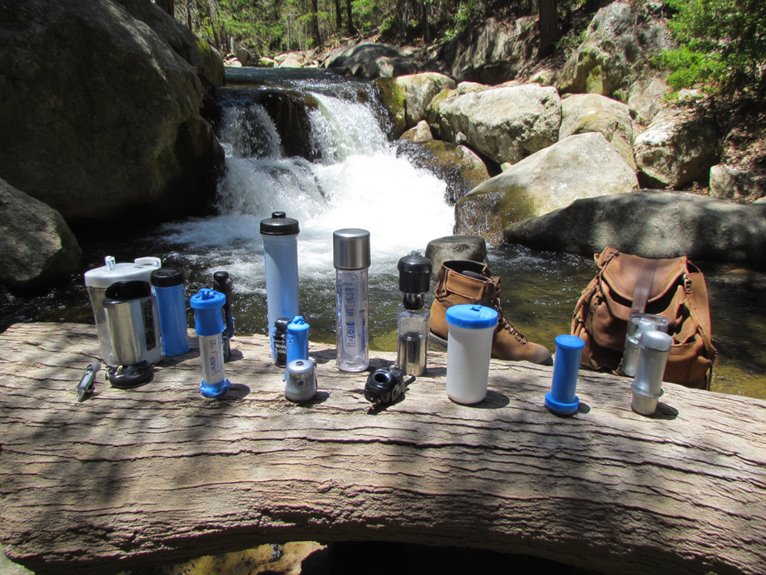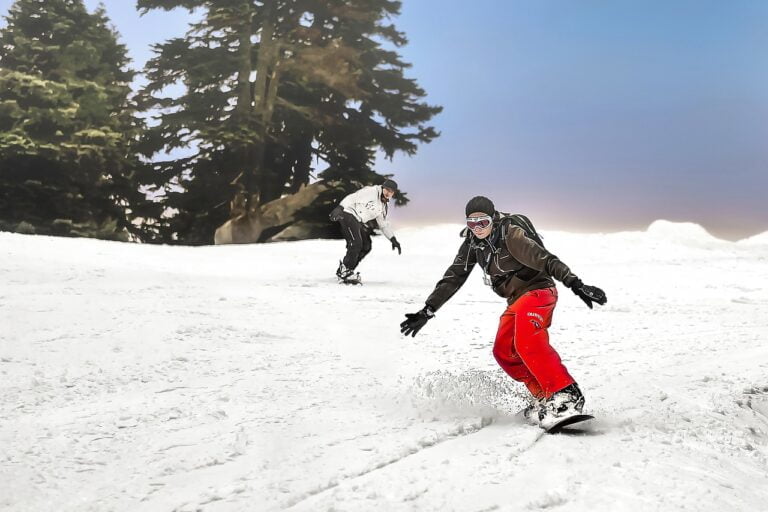How Warm Is a 10 Degree Sleeping Bag?
A 10-degree sleeping bag is designed to keep an average person comfortable in temperatures ranging from the mid-20s to mid-30s Fahrenheit (-4 to 1°C), making it a solid choice for three-season backpacking. The temperature rating indicates the lowest temperature at which the bag is designed to keep users comfortable, but individual factors like metabolism, clothing, and sleeping pad insulation can affect warmth. Understanding a sleeping bag's true warmth requires research into the manufacturer's testing methods and reviews from fellow campers. As you prepare for your next adventure, the nuances of temperature ratings await, ready to guarantee a restful night's sleep under the stars.
We are supported by our audience. When you purchase through links on our site, we may earn an affiliate commission, at no extra cost for you. Learn more. Last update on 12th December 2025 / Images from Amazon Product Advertising API.
Understanding Sleeping Bag Temperature Ratings
When selecting a sleeping bag, understanding its temperature rating is essential, as it directly impacts the quality of your outdoor adventure, and a misjudged rating can be the difference between a comfortable night's sleep and a shivering, sleepless night.
A sleeping bag's temperature rating indicates the lowest temperature at which the bag is designed to keep you comfortable. Ratings are usually provided by the manufacturer and are based on standardized testing protocols.
It's necessary to take into account factors like your personal comfort level, the environment, and the bag's features when choosing a sleeping bag.
A thorough comprehension of temperature ratings guarantees you're prepared for a restful night's sleep under the stars. By grasping this fundamental aspect, you can focus on enjoying the great outdoors, rather than worrying about a chilly night's sleep.
What Does 10 Degrees Really Mean
As we delve into the nuances of sleeping bag temperature ratings, it's essential to understand the intricacies of the temperature rating scale, which can be influenced by various factors, leading to rating variances between manufacturers.
Additionally, real-world testing has shown that these ratings may not always translate to actual sleeping conditions.
Temperature Rating Scale
The temperature rating scale, a crucial aspect of sleeping bag design, is often shrouded in mystery, leaving many outdoor enthusiasts wondering what a 10-degree rating truly entails.
In reality, the temperature rating scale refers to the lowest temperature at which a sleeping bag is designed to keep an average person comfortable.
This comfort zone is typically defined as a temperature range where a person can sleep in a 'relaxed' position, such as on their back, without waking up due to cold discomfort.
The rating is usually based on a series of laboratory tests, which simulate real-world conditions to determine the bag's insulation performance.
Rating Variance Exists
Despite its seemingly precise notation, a 10-degree sleeping bag rating can mean different things to different manufacturers, highlighting the need for outdoor enthusiasts to look beyond the number.
This disparity arises from the lack of a standardized testing protocol, allowing manufacturers to employ their own methods.
Some may use the European Norm (EN) 13537 standard, while others may employ proprietary testing procedures.
This inconsistency can result in varying levels of warmth and comfort, even among bags with the same rating.
To guarantee a good night's sleep, it's essential to research the manufacturer's testing methods and read reviews from fellow campers to get a more accurate understanding of a bag's true warmth.
Real World Testing
In the pursuit of a restful night's sleep under the stars, understanding the real-world implications of a 10-degree sleeping bag rating is essential, as laboratory testing can only translate so far to the unpredictable outdoor environment.
In reality, factors such as humidity, wind, and ground temperature can substantially impact the bag's performance.
Real-world testing is imperative to understand how a 10-degree sleeping bag will perform in various conditions.
Field testing in diverse environments and weather conditions helps to identify the bag's strengths and weaknesses.
This information is indispensable for campers, backpackers, and adventurers who rely on their sleeping gear to get a good night's rest.
Comfort Temperature Vs Survival Temperature
When dealing with sleeping bag temperature, understanding the distinction between comfort temperature and survival temperature is essential.
The comfort zone is where a person can sleep comfortably, while survival mode is engaged when the temperature drops to a point where the body's essential functions are at risk.
Comfort Zone Defined
Typically, outdoor enthusiasts and campers often find themselves torn between opting for a sleeping bag that provides a comfortable night's sleep and one that guarantees survival in extreme cold temperatures.
This dilemma highlights the importance of understanding the comfort zone of a sleeping bag. The comfort zone refers to the temperature range within which a person can sleep comfortably, without feeling too hot or cold.
This zone is typically characterized by a sense of relaxation and rejuvenation.
The comfort zone is usually 5-10°F (3-6°C) warmer than the survival temperature.
It is influenced by factors such as individual tolerance, sleeping pad insulation, and clothing.
A sleeping bag's comfort zone is critical in determining a restful night's sleep, making it an essential consideration for outdoor enthusiasts.
Survival Mode Engaged
While a sleeping bag's comfort zone is essential for a restful night's sleep, its survival temperature rating is equally imperative, as it marks the threshold below which the sleeper's life may be at risk.
This critical temperature rating signifies the lowest temperature at which a sleeping bag can keep a person alive, albeit not comfortably.
When the mercury drops below this point, the sleeper's body begins to succumb to hypothermia, making every minute count.
It's a delicate balance between staying warm and staying alive.
Understanding the distinction between comfort and survival temperatures is vital for adventurers, as it can mean the difference between a peaceful night's sleep and a fight for survival.
Temperature Thresholds
A sleeping bag's temperature thresholds, comprising comfort and survival ratings, serve as vital benchmarks for adventurers, demarcating the fine line between a restful night's sleep and a desperate struggle for survival.
Understanding these ratings is crucial, as they directly impact the quality of rest and, ultimately, the success of an expedition.
Comfort Temperature: The temperature at which a person can sleep comfortably, typically with a comfortable margin of warmth.
Survival Temperature: The minimum temperature at which a person can survive, albeit with some discomfort and potential health risks.
The gray area in between: Where the line between comfort and survival blurs, and adventurers must weigh the risks of hypothermia against the need for rest.
Factors Affecting Sleeping Bag Warmth
Beyond the rated temperature, several factors converge to influence a sleeping bag's warmth, including the user's metabolism, clothing worn, and sleeping pad insulation.
These individual factors can greatly impact the overall warmth of the sleeping bag.
A person's metabolism, for instance, can greatly affect how warm they feel in their sleeping bag. Those with a faster metabolism tend to sleep warmer, while those with a slower metabolism may feel colder.
In the same way, the type and thickness of clothing worn to bed can also influence the sleeping bag's warmth.
Additionally, the insulation provided by the sleeping pad can also play a vital role in maintaining a comfortable temperature.
Real-World Experience With 10-Degree Bags
In the domain of backpacking, many enthusiasts have put 10-degree sleeping bags to the test, pushing their limits in freezing temperatures to uncover the true extent of their warmth.
Real-world experiences have shown that these bags can perform admirably in temperatures slightly below their rated temperature, but may not always live up to their claimed rating.
Some users have reported staying comfortable down to 15°F (-9°C) with a 10-degree bag, but this is not always the case.
Others have noted that factors like humidity, wind, and sleeping pad insulation can substantially impact the bag's performance.
However, most agree that a 10-degree bag is a solid choice for three-season backpacking, providing a comfortable night's sleep in temperatures ranging from the mid-20s to mid-30s Fahrenheit (-4 to 1°C).
Choosing the Right Sleeping Bag
Selecting a sleeping bag that aligns with your backpacking goals and environmental expectations is essential, as even the most experienced enthusiasts can attest to the importance of a good night's sleep in the wilderness.
When choosing the right sleeping bag, consider factors such as temperature rating, insulation type, and moisture resistance.
Consider the lowest temperature you expect to encounter on your adventure and choose a bag rated for that temperature or lower.
Additionally, think about the activities you'll be doing and the terrain you'll be in – if you'll be camping in wet conditions, look for a bag with a water-resistant treatment.



